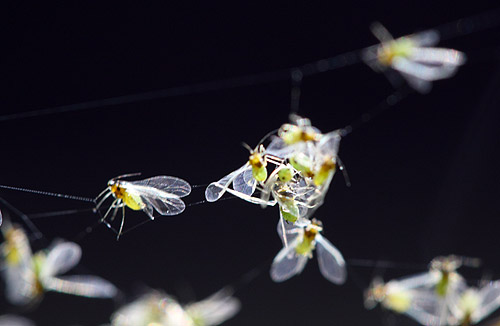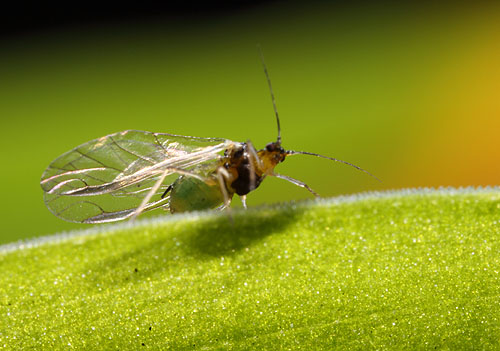
Soybean aphids piling up in a spider web
It's been snowing aphids the past few days here in Champaign-Urbana. Trillions of them are drifting across town, settling out on our garden, getting caught in our hair. I've never seen anything like it.
I recently learned that this sternorrhynchan storm is composed of soybean aphids (Aphis glycines). That would explain all the aphid biomass. Illinois is a major producer of soy, and there's no shortage of soy fields around here. Sensing the end of summer, the aphids are moving en masse to their winter host, buckthorn.

Soy has traditionally been easy to grow in North America as it lacked any major insect pests. Until about 10 years ago, that is. That's when the first soybean aphids, an Asian species, showed up in Wisconsin. Given the sheer numbers of these insects, I can't imagine this bodes well for soy yields this year.

***update (9/21): I've added an Aphid FAQ

Maybe (I almost hope) these aphids will become vectors for some horrible buckthorn disease, thus reducing the impact of Rhamnus cathartica, a notorious invasive species from Asia that is causing considerable ecological degradation in upper Midwestern forests and woodlands.
Buckthorn-infested habitats support only a very few common species of native forest ants (or indeed of any native fauna or flora), and typically only low populations of these species. Buckthorns also modify soil chemistry and microbial floras such that areas infested by them are quite difficult to restore to native biological diversity.
it's raining aphids! hallelujah it's raining aphids!
This aphid is actually a huge problem, and the sheer biomass only 10 (or so) years after introduction is absolutely amazing, and speaks to the massive invasive potential of aphids in general.
George Heimpel suggests that this whole thing is an invasion meltdown initiated by introduced earthworms, which modify the soil to favor buckthorn growth, which then favors the growth of aphids, which then are good food for the invasive ladybug Harmonia axyridis.
Need more birds.
Friggin' invasive earthworms. I hate those things. It figures they'd be involved.
It speaks more to the large scale farming. Who would have thought a sea of corn and soy would lead to massive population of insects that attack soy?
And bats!
seriously, if we planted a variety of things without using pesticides, then the sheer mass of one type of bug would be avoided.
Holy cripes, so that's what these things are. I took a bike ride today and had to wear sunglasses to keep them out of my eyes. My hair, arms, face, everything was covered in them when I got back. Even walking around I get them in my eyes. I sure hope something that eats them finds it's way to Champaign soon.
I want to kill them all.
I haven't heard much mention of it, but usually at this time of year I have hundreds of those orange (asian) lady bugs crawling on my house, and thousands on my elm trees. Not un-coincidentally, I am sure, I haven't seen ONE this year.
Has there been a massive die off in the aphids natural predators? I would have thought someone besides myself would have noticed the lack of ladybugs. They are usually everywhere in the fall.
Funny thing is, I used to think that THEY were a pain. Of course, now I miss them.
I hear that aphids are attracted to liberals, to scourge them for all the wrong they have done over the years. I know that the uiuc campus is a haven for dirty liberal hippies, who actually know nothing about politics and/or economics and think that barack obama is an awesome president. this explains the larger number of aphids in the urbana area. i think we should oust the liberals from urbana to make these annoying aphids go away. even if they dont go away, another problem is solved in the process.
Seriously, you had to go there? :/
Anyway, I'd like to reply to the article and give my compliments because this was a good, informative article. Now I know more about these pesky little "friends" of mine who like to take up residence in my beard as I walk to and from class. -_-
That dog won't hunt. We've got them up here in the Peoria area as well: *sigh* Aaron Schock's district and a *sigh* hotbed of ironic neocon outrage.
Hi!
My name is Ngoc. I am a student in CanTho university (VietNamese). I sent this mail because I want to required some infomation about Soybean aphid.
Thanks!
Kim Ngoc